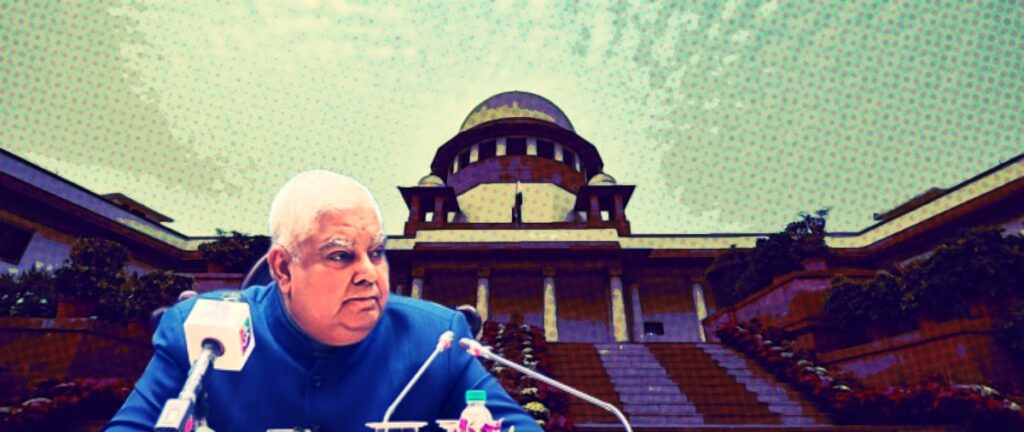The recent statement by vice-president Jagdeep Dhankhar questioning the Supreme Court’s April 1973 verdict in the Kesavananda Bharati case that put the basic structure of the constitution beyond the reach of parliament was met with considerable shock.
The move by a constitutional authority to undermine the very framework of the constitution that he is meant to guard to favour the Parliament – a product of the constitution – was met with many arguments that questioned him. It prompted the Indian Express to remind him that during the Emergency, he was a leader of the Janata Dal, the party that positioned itself against then Prime Minister Indira Gandhi’s attempts to dismantle the ‘basic structure’ of the constitution. It added that he, as a lawyer, is surely aware of the perils that “using the people’s mandate as unfettered license” can bring to democracy. The newspaper also reminded Dhankhar that Mrs Gandhi’s autocratic government retaliated against the Supreme Court’s Kesavananda verdict by “rewarding” the judge who had sided with her in the case, making him the next chief justice of India (CJI). That CJI went on to aid Mrs Gandhi’s government in several other cases throughout the Emergency.
Going a step ahead, Deccan Herald reprimanded the seasoned politician – who is now batting for the Bharatiya Janata Party (BJP) – by cautioning him that “parliament is not sovereign”. It said: “It is the constitution that is supreme. The parliament is a creature of the constitution.”
Calling it a “mischievous idea”, the newspaper said that if the basic structure doesn’t exist, then the constitution will be a “devalued document”. [The Decccan Herald article goes on to say: “In the absence of the doctrine, parliament can pass any law abridging fundamental rights, including the rights to life and equality, undermining the rule of law, abandoning the parliamentary form of government, and doing away with the separation of powers and judicial review. What will remain of our democracy then?” – addition by Editors, Janata Weekly] The editorial has, indirectly, put the point posited by Dhankhar within the precincts of the Hindutva brigade’s core aim of amending the constitution someday.
There is little doubt left in most minds anymore that what is standing in the way of the Rashtriya Swayamsevak Sangh (RSS)’s dream of a Hindu rashtra is the present frame of the constitution. This is the reason why there has been a constant assertion on the need to amend it in the name of ‘Bhartiyata’ by the RSS and the Sangh Parivar.
Without a doubt, the RSS is today the most influential non-governmental organisation – it has the Narendra Modi dispensation’s ear. In such a reality, should Dhankar’s statement not be seen within that purview? Are we to then ask, was it an attempt to kick off a debate on the matter, as often suggested by RSS chief Mohan Bhagwat, and weigh in on what exactly stands in the way of the Modi government tinkering with the constitution to usher in a full-fledged Hindu rashtra?
If one religion is given primacy over the rest, it is not rocket science to fathom that what the constitution’s guarantee – that all citizens irrespective of caste, creed, region and religion are treated equally by the state – may cease to exist.
It is therefore worthwhile to dive a little deeper to understand what dangers to democracy and the Indian Union that the Supreme Court’s 1973 verdict had hoped to avoid in the future.
A dark path
Here, focusing on the very stimulus behind that judgment of the special 13-judge bench of the apex court is key – as it takes us to the door of Nazi Germany, a fascist government that consumed millions of innocent people in the name of establishing the supremacy of a race.
History has the propensity to impart lessons – if one cares to heed it. In view of Dhankhar’s statement, it is perhaps time to flip back in history.
In 1933, Adolf Hitler won the most number of seats in the German parliament but fell short of a majority. He leaned on majoritarian support to subvert the Weimer constitution – by crying foul of ‘traitors within’ (akin to ‘anti-nationals’ that we hear today in India). To grab absolute power, the German cabinet led by Hitler brought in the Enabling Act of 1933, which gave the powers to make laws to the cabinet – or rather to Hitler, as the leader of the cabinet. It allowed him to bypass the president, as required by the constitution. A year later, he declared himself the chancellor and the chief of the German army.
The Weimar constitution remained on paper throughout the Nazi era but Hitler was able to oversee some of the worst state-sponsored crimes in history because that Act essentially defanged the basic structure of the constitution. In other words, the Enabling Act ultimately facilitated the undermining of democracy in Germany by curtailing civil rights and giving rise to Nazi Germany and dictatorship, crushing easily under the jackboots of state power Hitler’s opponents and a set of citizens that he and his party abhorred in the name of race and religion – the minority Jews. Let the intention of the argument here be clear – Hitler’s mission towards dictatorship and annihilation of his opponents could succeed only because he could tinker with the basic structure of the Weimer constitution. The Act, therefore, retains significance in the global study of democracy.
After Hitler’s downfall, what took precedence in Germany was the need to make the basic frame of the German constitution tamperproof so that no dictator (even if an elected leader like Hitler grabs power once again) could drag the country back into that black hole. In came Article 79 (3) of the Basic Law of the Federal Republic in 1949.
What prompted Kesavanada judgment?
The stimulus for the Indian Supreme Court’s April 1973 verdict in favour of making the basic structure of the Indian constitution sacrosanct is often said to be drawn from eminent German jurist and scholar Dietrich Conrad, an ardent votary of the need to protect the basic frame of a constitution from any party that may grab a large number of seats in parliament and act in any which way it fancies. Noted lawyer and political commentator A.G. Noorani pointed out in an insightful article in Frontline in 2001:
“It was no mere coincidence that a German jurist had thought of implied limitations on the amending power. Article 79(3) of the Basic Law of the Federal Republic of Germany, adopted on May 8, 1949, six months before the drafting of India’s Constitution ended, bars explicitly amendments to provisions concerning the federal structure and to ‘the basic principles laid down in Articles 1 and 20 (on human rights and the ‘democratic and social’ set-up). The Germans learnt from the bitter experience of the Nazi era. The framers of the Constitution of India [had, however] refused to look beyond the Commonwealth countries and the United States.”
The SC’s 1973 verdict helped achieve what the framers of the constitution did not. Though that verdict – stalling parliament from amending the basic structure of the constitution – is often said to have been influenced by the Nazi Germany example as held up by Conrad, the first such argument – also citing Conrad – was made by one of India’s distinguished constitutional lawyers, M.K. Nambyar, in the 1967 Golak Nath case. Noorani had underlined that Conrad, who taught law at the Heidelberg University, was on a visit to the Banaras Hindu University in 1965. During that visit, he delivered a lecture on “Implied Limitations to the Amending Power” at the law faculty of the BHU. “A paper based on the subject was sent to Prof. T.R. Rama Rao in Madras for his comments. Nambyar’s attention was drawn to this paper which he read before the Supreme Court, though with little result,” wrote Noorani.
Though “considerable force” in Nambyar’s argument was acknowledged by the 11-judge bench that dealt with the Golaknath case, it eventually set it aside stating, “This question may arise for consideration only if parliament seeks to destroy the structure of the constitution embodied in provisions other than in Part III of the constitution.”
Noorani had highlighted that Conrad, in his lecture at BHU, had underlined that even if “the SC is influenced by the fact that so far it has not been confronted with any extreme type of constitutional amendments”, it is however, the “duty of the jurists” to anticipate it.
Like in the Golaknath judgement, in the Kesavananda Bharati case of 1973 too, the SC’s special bench was equally divided in their opinion on the matter. It was only Justice H.R. Khanna’s observation that tipped the balance in favour of making the basic structure of the constitution tamper-proof from parliament.
Justice Khanna went on to pay a huge price for his judgment professionally. When it was his time to be the next CJI in 1977, the Indira regime ensured that he was superseded, forcing him to resign. The trend of cherry-picking CJIs as per the whim of the Union government was, however, set just a day after the 1973 verdict though. Mrs Gandhi picked Justice A.N. Ray as the CJI after Justice S.M. Sikri who had led the 13-judge bench by superseding some of the justices who had favoured protecting the basic structure of the constitution from parliament.
However, the professional sacrifice made by those SC judges to uphold the rule of law and protect the primacy of the constitution in a democracy – even from an elected government – aided India in finally defeating the Emergency. Omair Ahmad had rightly pointed out in an article in the Hindu Business Line in 2018 that: “In 1975, Mrs Gandhi had come up with a Bill to amend Article 361 of the Constitution, disallowing any criminal proceeding against the Prime Minister. It was dropped, no doubt because the government’s legal advisors probably warned that such a Bill would be struck down because of the ‘basic structure’ doctrine espoused in the 1973 Kesavananda Bharati case.”
Alas, 50 years hence, India is facing an attack on the basic structure of the constitution from none other than a constitutional authority – in an effort to make parliament, and thereby the prime minister, the supreme power.
In 2021, former President Ram Nath Kovind broke an unwritten protocol to inaugurate a sports stadium named after Narendra Modi. Dhankhar’s recent statement must be seen as the next significant move by a top constitutional authority to help project the Parliament, and thereby the prime minister, as the de facto head of Indian democracy, not just the head of the government.
(Courtesy: The Wire.)
❈ ❈ ❈
[A.G. Noorani, in the above quoted article in Frontline – “Behind the ‘Basic Structure’ Doctrine” – also says (extract):]
The Supreme Court of India has since affirmed “the basic structure” doctrine in a series of rulings without demur.
What is little known in India is that this doctrine has now spread far and wide beyond its frontiers. In the 1950s and 1960s, Part III of the Constitution, embodying the fundamental rights, was emulated in the Constitution of many a Commonwealth country, including Pakistan’s in 1956. In the last two decades, the Supreme Court’s achievement has been acclaimed and adopted by courts in foreign lands.
There is, sadly, little acknowledgment in India of that debt we owe to a distinguished German jurist and a scholar steeped in other disciplines beyond the confines of law – Professor Dietrich Conrad, formerly Head of the Law Department, South Asia Institute of the University of Heidelberg, Germany.
In February 1965, while on a visit to India, Conrad delivered a lecture on “Implied Limitations of the Amending Power” to the Law Faculty of the Banaras Hindu University. Prof. Conrad’s lecture, delivered in February 1965, showed remarkable perceptiveness besides deep learning. He observed:
“Perhaps the position of the Supreme Court is influenced by the fact that it has not so far been confronted with any extreme type of constitutional amendments. It is the duty of the jurist, though, to anticipate extreme cases of conflict, and sometimes only extreme tests reveal the true nature of a legal concept. So, if for the purpose of legal discussion, I may propose some fictive amendment laws to you, could it still be considered a valid exercise of the amendment power conferred by Article 368 if a two-thirds majority changed Article 1 by dividing India into two States of Tamilnad and Hindustan proper?
“Could a constitutional amendment abolish Article 21, to the effect that forthwith a person could be deprived of his life or personal liberty without authorisation by law? Could the ruling party, if it sees its majority shrinking, amend Article 368 to the effect that the amending power rests with the President acting on the advice of the Prime Minister? Could the amending power be used to abolish the Constitution and reintroduce, let us say, the rule of a moghul emperor or of the Crown of England? I do not want, by posing such questions, to provoke easy answers. But I should like to acquaint you with the discussion which took place on such questions among constitutional lawyers in Germany in the Weimar period – discussion, seeming academic at first, but suddenly illustrated by history in a drastic and terrible manner.”
It is, again, to Prof. Dietrich Conrad that we owe a mass of information on the spread of the “basic structure” doctrine in a lecture on “Basic Structure of the Constitution and Constitutional Principles,” delivered at the Indian Law Institute in New Delhi on April 2, 1996. It was published in Law and Justice, a journal of the United Lawyers Association, New Delhi (Vol. 3, Nos. 1-4; pages 99-114).
Prof. Conrad aptly remarked that “in this free trade of constitutional ideas the Indian Supreme Court has come to play the role of an exporter. This holds true with respect to at least two major innovations introduced by the court”; namely, public interest litigation and “the basic structure doctrine”. The doctrine was adopted by the Supreme court of Bangladesh in 1989 expressly relying on the reasoning in the Kesavananda case of 1973 (Anwar Hossain Chowdhary vs. Bangladesh; 41 DLR 1989 App. Div. 165, 1989 BLD (Spl.) 1).
Prof. Conrad added: “Recently, in the famous case on judicial appointments, the Pakistan Supreme Court has come very close to recognising a “basic structure” limitation on the power of amendment. In fact it is amazing to see how they could arrive at certain conclusions and still evade an express recognition of the doctrine” (Al-Jehad Trust vs. Federation of Pakistan; PLD 1996 SC. 367).
Prof. Conrad concluded his tour d’horizon by saying that “the concept of a basic structure giving coherence and durability to a Constitution has a certain intrinsic force which would account for its appearance in various jurisdictions and under different circumstances. It remains to take a closer look at some implications of this theory as they appear from comparative constitutional experience.
(A.G. Noorani is an Indian lawyer, constitutional expert and political commentator. Courtesy: Frontline, Volume 18 – Issue 09, Apr. 28 – May 11, 2001.)




